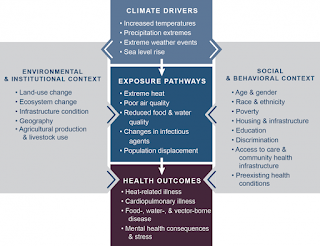"Global warming is spreading insect-borne diseases." This was the headline of the May 12 Citizens'
Climate Lobby Blog Post. The Centers for
Disease Control (CDC) recently released a report that found diseases
spread by ticks, mosquitoes, and fleas more than tripled in the U.S. from 2004
to 2016, due largely to the Zika virus outbreak in 2015. In analyzing this report we learn that:
·
Mosquitoes and
ticks thrive in hotter temperatures caused by global warming.
·
Warmer
temperatures tend to make mosquitoes get infected faster and be more
infectious.
·
Higher
temperatures allow ticks to spread into new areas farther north.
·
When the tick
season is longer, people are exposed over longer periods.
A story from Newsweek on April 10 (Allergy Season
2018: Starting Earlier, Lasting Longer), citing a report by the
American Academy of Allergy, Asthma & Immunology, claims that "as the
climate changes and temperatures rise, the amount of pollen in the air and the
length of time it stays there increase. This combination means worsening
allergy seasons to come for many."
These are only a couple of the impacts on human health that
climate change causes. Believe it or
not, there is still a government website that hasn't been taken down yet, that
addresses these impacts: The Impacts
of Climate Change on Human Health in the United States: A Scientific
Assessment. The Introduction begins:
Climate change is a significant
threat to the health of the American people. The impacts of human-induced
climate change are increasing nationwide. Rising greenhouse gas concentrations
result in increases in temperature, changes in precipitation, increases in the
frequency and intensity of some extreme weather events, and rising sea levels.
These climate change impacts endanger our health by affecting our food and
water sources, the air we breathe, the weather we experience, and our
interactions with the built and natural environments. As the climate continues
to change, the risks to human health continue to grow.
Chapter 1 spells out how Climate Drivers produce Exposure
Pathways giving adverse Health Outcomes.
Figure 1
Chapter 2 discusses Temperature-Related Death and
Illness. Chapter 3 addresses Air Quality
Impacts. The following chapters cover:
4-Extreme Events; 5-Vector-Borne Diseases; 6-Water-Related Illness; 7-Food
Safety, Nutrition, and Distribution; 8-Mental Health and Well-Being; and
9-Populations of Concern.
The reality of temperature-related deaths was demonstrated
recently in Karachi, Pakistan. See May
29 New York Times story, Looking
for a Bit of Shade as Intense Heat Wave Hits Karachi. Karachi is accustomed to heat waves this time
of year, but this year in mid-May temperatures soared above 43°C (more than
110° F)! The heat radiated from roads
and cement buildings well into the night.
The heat spiked on May 18, just days after the beginning of Ramadan,
when Muslims are required to abstain from food and water from sunrise to
sunset. The death toll reached 65 that
day.
It's been worse. In
June of 2015, more than a thousand people died in the span of 2 weeks in
Karachi.
Regarding food nutrition, a New York Times article from May
24, How
More Carbon Dioxide Can Make Food Less Nutritious, reports
that researchers in a new study find that increased concentration of carbon
dioxide in the atmosphere is affecting the chemical composition of crops. Not only do rising temperatures and frequent
droughts damage harvests, but the extra carbon dioxide that humanity is pumping
into the atmosphere is making some of our most important crops less nutritious
by diluting their vitamins and minerals.
This latest study builds on an earlier one published in Nature in 2014, which found that
elevated levels of carbon dioxide reduced the amount of zinc and iron found in
wheat, rice, field peas and soybeans.
Beyond all this is the toll exacted on the mental
health of the victims of extreme weather events. There is the anxiety, despair, grief, and
death that accompany hurricanes, floods, blizzards, and wildfires. Who can count the tears witnessed on news
reports of the October wildfires here in Northern California. "We've lost everything!" is a
lament repeated over and over. Hurricane
Harvey flooded square miles of the Houston area and caused the land to sink
several centimeters. Hurricane Maria
killed over 4000 people in Puerto Rico during its rampage and aftermath. Force 4 tornadoes rampage through the midwest
causing death, destruction, and displacement.
Then winter comes with bomb cyclones, polar vortexes, arctic blasts, and
more. These extreme cold assaults are in
fact a direct result of global warming, contrary to unscientific popular
belief. See Scientific American
Earthtalk story: Why
Global Warming Can Mean Harsher Winter Weather. The devastation on ice-covered highways is
only one source of loss and grief.
While it's true that earthquakes, volcanoes, and
war (all of which can be indirectly caused by climate change)
terrify, displace, and kill people, there is much less we as citizens can do
about those. But the disasters caused by
climate change are within our power to mitigate. We humans started the planet warming
unnaturally, and we humans can stop it.
As was pointed out in the lead reference for this article, "people
don’t often realize that climate change is already impacting us in adverse
ways. As a result, we tend to underestimate
the urgency of the problem and consider it a low priority." If you drop a frog into a pot of hot water,
he will hop right out. But if the water
is cool and gradually heated to boiling, the frog will sit there, complacent,
until he's cooked.
Let's not sit here on
this planet doing nothing until we're cooked!
Additional references:
Climate Change and Human Health
https://www.niehs.nih.gov/health/materials/climate_change_and_human_health_508.pdf
https://www.niehs.nih.gov/health/materials/climate_change_and_human_health_508.pdf
Impact of Climate Change on Human Health
https://www.geo.lu.lv/fileadmin/user_upload/lu_portal/projekti/gzzf/videunilgtspejigaattistiba/7._Climate_change_and_human_health.pdf
https://www.geo.lu.lv/fileadmin/user_upload/lu_portal/projekti/gzzf/videunilgtspejigaattistiba/7._Climate_change_and_human_health.pdf
Climate change and human health: Risks and responses
http://www.who.int/globalchange/publications/climchange.pdf
http://www.who.int/globalchange/publications/climchange.pdf
The Impacts of Climate Change on Human Health in the United
States: A Scientific Assessment
https://www.epa.gov/sites/production/files/2016-06/documents/crimmons_climate_health_presentation062916.pdf
https://www.epa.gov/sites/production/files/2016-06/documents/crimmons_climate_health_presentation062916.pdf

.jpg)